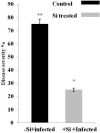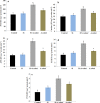Silicon supplementation improves early blight resistance in Lycopersicon esculentum Mill . by modulating the expression of defense-related genes and antioxidant enzymes
- PMID: 33968576
- PMCID: PMC8062669
- DOI: 10.1007/s13205-021-02789-6
Silicon supplementation improves early blight resistance in Lycopersicon esculentum Mill . by modulating the expression of defense-related genes and antioxidant enzymes
Abstract
Early blight is the most devastating disease in tomato which causes huge yield losses across the globe. Hence, development of specific, efficient and ecofriendly tools are required to increase the disease resistance in tomato plants. Here, we systematically investigate the defensive role and priming effect of silicon (Si) in tomato plants under control and infected conditions. Based on the results, Si-treated tomato plants showed improved resistance to Alternaria solani as there was delay in symptoms and reduced disease severity than non-Si-treated plants. To further examine the Si-mediated molecular priming in tomato plants, expression profiling of defense-related genes like PR1, PR2, WRKYII, PR3, LOXD and JERF3 was studied in control, Si-supplemented, A. solani-inoculated and Si + A. solani-inoculated plants. Interestingly, Si significantly increased the expression of jasmonic acid (JA) marker genes (PR3, LOXD and JERF3) than salicylic acid (SA) marker genes (PR1, PR2 and WRKYII). However, Si + A. solani-inoculated plants showed higher expression levels of defence genes except WRKYII than A. solani-inoculated or Si-treated plants. Furthermore, pre-supplementation of Si to A. solani-infected tomato plants showed increased activity of antioxidant enzymes viz. superoxide dismutase (SOD), catalase (CAT), ascorbate peroxidase (APX), glutathione reductase (GR) and peroxidase (POD) than control, Si-treated and A. solani-inoculated plants. Altogether, present study highlights the defensive role of Si in tomato plants in response to A. solani by increasing not only the transcript levels of defense signature genes, but also the activity of antioxidant enzymes.
Keywords: Alternaria solani; Antioxidant enzymes; Early blight; Lycopersicon esculentum; PR genes; Silicon.
© King Abdulaziz City for Science and Technology 2021.
Conflict of interest statement
Conflict of interestThe authors declare that there is no conflict of interest.
Figures





Similar articles
-
[Mechanism of tomato plants enhanced disease resistance against early blight primed by arbuscular mycorrhizal fungus Glomus versiforme].Ying Yong Sheng Tai Xue Bao. 2011 Sep;22(9):2316-24. Ying Yong Sheng Tai Xue Bao. 2011. PMID: 22126042 Chinese.
-
Enhanced tomato disease resistance primed by arbuscular mycorrhizal fungus.Front Plant Sci. 2015 Sep 28;6:786. doi: 10.3389/fpls.2015.00786. eCollection 2015. Front Plant Sci. 2015. PMID: 26442091 Free PMC article.
-
[Silicon application enhances resistance to sheath blight (Rhizoctonia solani) in rice].Zhi Wu Sheng Li Yu Fen Zi Sheng Wu Xue Xue Bao. 2006 Oct;32(5):600-6. Zhi Wu Sheng Li Yu Fen Zi Sheng Wu Xue Xue Bao. 2006. PMID: 17075186 Chinese.
-
Binucleate Rhizoctonia induced tomato resistance against Rhizoctonia solani via affecting antioxidants and cell wall reinforcement.Heliyon. 2024 Mar 20;10(6):e27881. doi: 10.1016/j.heliyon.2024.e27881. eCollection 2024 Mar 30. Heliyon. 2024. PMID: 38545156 Free PMC article.
-
Phytohormone Priming of Tomato Plants Evoke Differential Behavior in Rhizoctonia solani During Infection, With Salicylate Priming Imparting Greater Tolerance Than Jasmonate.Front Plant Sci. 2022 Jan 10;12:766095. doi: 10.3389/fpls.2021.766095. eCollection 2021. Front Plant Sci. 2022. PMID: 35082805 Free PMC article.
Cited by
-
Sodium silicate promotes wound healing by inducing the deposition of suberin polyphenolic and lignin in potato tubers.Front Plant Sci. 2022 Aug 25;13:942022. doi: 10.3389/fpls.2022.942022. eCollection 2022. Front Plant Sci. 2022. PMID: 36092440 Free PMC article.
-
Advances in the Involvement of Metals and Metalloids in Plant Defense Response to External Stress.Plants (Basel). 2024 Jan 20;13(2):313. doi: 10.3390/plants13020313. Plants (Basel). 2024. PMID: 38276769 Free PMC article. Review.
-
Chitosan, Methyl Jasmonate, and Silicon Induce Resistance to Angular Leaf Spot in Common Bean, Caused by Pseudocercospora griseola, with Expression of Defense-Related Genes and Enzyme Activities.Plants (Basel). 2024 Oct 18;13(20):2915. doi: 10.3390/plants13202915. Plants (Basel). 2024. PMID: 39458862 Free PMC article.
-
Exploration of silicon functions to integrate with biotic stress tolerance and crop improvement.Biol Res. 2021 Jul 8;54(1):19. doi: 10.1186/s40659-021-00344-4. Biol Res. 2021. PMID: 34238380 Free PMC article. Review.
-
How do plants defend themselves against pathogens-Biochemical mechanisms and genetic interventions.Physiol Mol Biol Plants. 2022 Feb;28(2):485-504. doi: 10.1007/s12298-022-01146-y. Epub 2022 Mar 7. Physiol Mol Biol Plants. 2022. PMID: 35400890 Free PMC article. Review.
References
-
- Al-aghabary K, Zhu Z, Shi Q. Influence of silicon supply on chlorophyll content, chlorophyll fluorescence, and antioxidative enzyme activities in tomato plants under salt stress. J Plant Nutr. 2005;27:2101–2115. doi: 10.1081/pln-200034641. - DOI
LinkOut - more resources
Full Text Sources
Other Literature Sources
Research Materials
Miscellaneous

